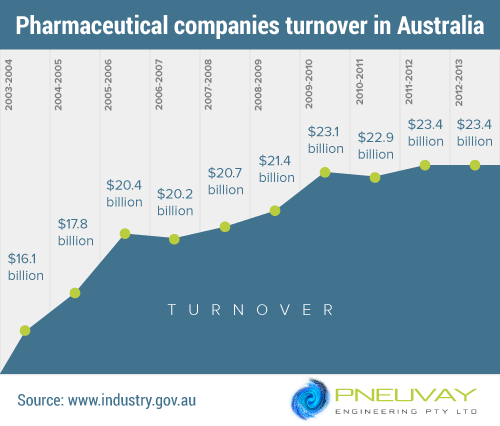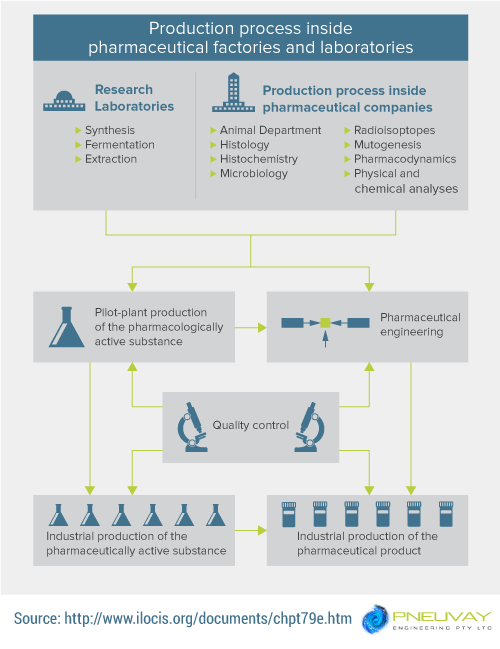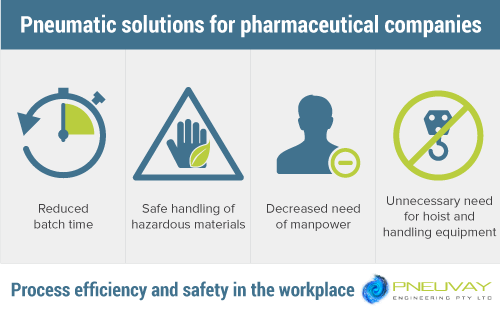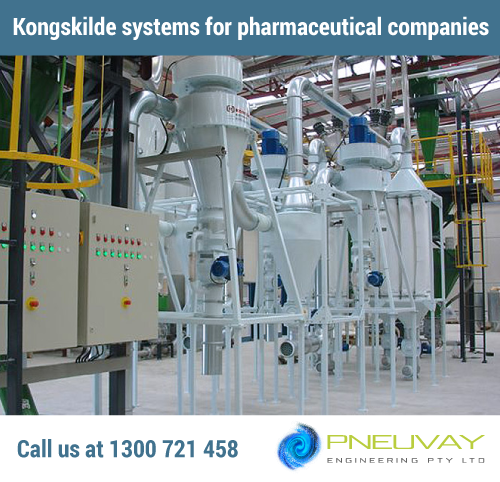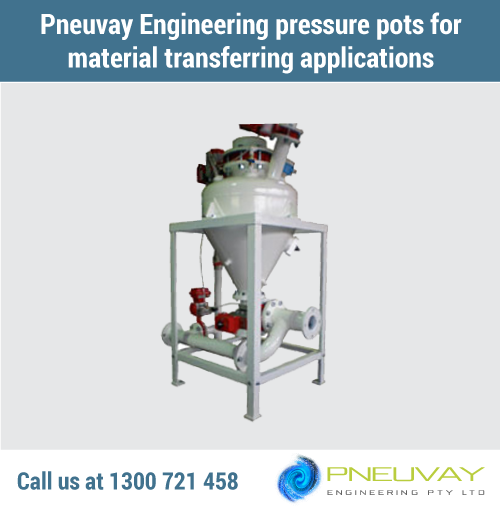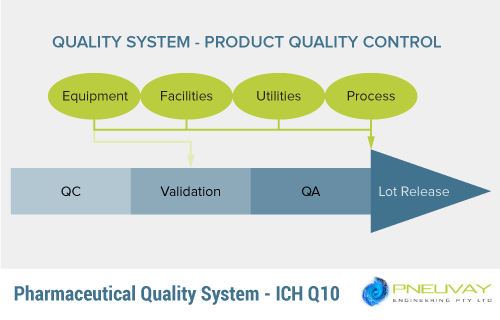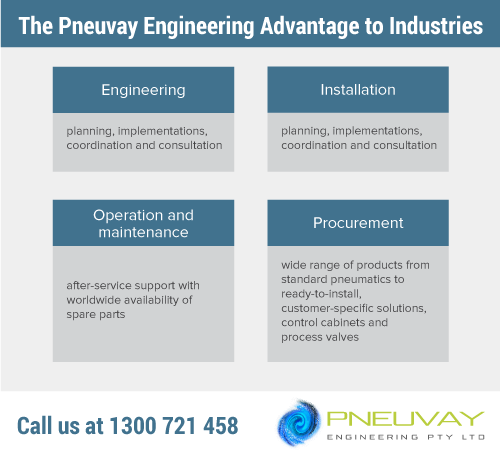Pneumatic systems require less cleaning maintenance, especially when dealing with materials of a chalky consistency. This helps prevents:
A closed system extends an equipment’s life. It eliminates the need to open the inspection hatches, therefore, keeping damage and deterioration at bay. Both the agitator and seal system remains intact protecting your equipment from damage while the materials are loaded into it.
It is vital for pharmaceutical companies to ensure that batch purity is maintained at all levels. Use of pneumatic conveying system's sealed pipings ensures cleaner installation and process flows due to its sealed piping design.
Pneumatic conveying applications to the pharmaceutical industry
As pointed out above, pneumatic conveying can provide pharmaceutical companies additional levels of employee safety, equipment life and product quality. The list below shows how this is implemented in various applications.
Conveying and dispensing of pharmaceutical powders
One application of pneumatic conveying is the use of vacuum transfer systems, which can be adapted to fit a variety of materials sources.
Pharmaceutical powders stored in different containers, like open drums for non-hazardous materials, can be easily transferred via a vacuum system using a pickup wand or hand nozzle.
Should a higher containment level be needed, equipment add-ons like specialty glove box design pickup bins can be streamlined into the vacuum line, better protecting the product and the equipment operator.
Air swept sieving (check screening)
Air swept sieving or check screening uses vacuum conveying for operations such as feeding conical screen mills and in-line sifting. It serves the following purposes:
- Improve process throughput
- Prevent material exposure and keep out dust
- Aid in ensuring end-product quality
This process is usually performed using a dilute-phase vacuum stream.
Conveying with a process in line requires that the equipment in question be sealed; it must also be suitable for vacuum operations. The equipment comes with an in-line deck or rotary sieves and conical screen mills.
In both cases, materials can be picked up from different sources like IBCs, bag dump stations, drums, or other processes. The materials are then transferred via the equipment and into a vacuum receiver.
In conical screen mills, the use of operation under vacuum enables the product to go in and out quicker. The smaller the amount of time the product spends in the mill, the better the product quality.
Without the attrition induced by the added circulation in the milling chamber, the amount of dust produced by the mill is reduced, ultimately improving the end product’s particle size distribution.
In-line sieving operations also function under the same principle for better product quality. By lessening overall residence time, product attrition and degradation are prevented.
Pneumatic vacuum receivers as refill devices for loss-in-weight feeders
In operations where continuous refill from containers are required, pneumatic receivers running under a dilute-phase vacuum transfer principle can serve as efficient refill devices.
Using a simple flap valve, the pneumatic system uses negative pressure to suck the material into a separate mounted and supported vacuum receiver.
The receiver holds the material charge until the feeder below it requests a refill. The receiver is equipped with level sensors to determine the specified amount of fill the receiver will hold at a time.
Once the feeder asks for a refill, the discharge valve opens and the material held by the receiver is released into the feeder hopper.
In LIW feeding operations, the discharge valve is different. In order to prevent any chance of dribbling, the machine is fitted with a pneumatic butterfly valve type.
An air pulse is sent through the filter inside the vacuum receiver to clean the filter once materials are discharged. This eliminates any entrained particle that may have settled on the filter.
Various filter materials can be selected to suit the conveyed material. Some are anti-static and have laminated membranes for quick discharge and bothersome-free cleaning properties.
Once the material has been transferred into the feeder hopper, the valve closes again, and the vacuum receiver cycle automatically restarts for an uninterrupted source of refill. In other cases, the flap system can be replaced with a Pneuvay rotary valve which will provide smooth consistent flow- through rather than batching.
Alternate conveying for pre-blended or fragile materials: dense-phase vacuum
Dense-phase conveying also has a place in pharmaceutics processing.
This type of pneumatic conveying has lower gas velocity, which means that the force exerted on powders being transferred is much gentler. This solves segregation issues often encountered in dilute-phase operations.
However, dense-phase conveying has limitations like not being able to cover conveying distances of over 12 ft (vertical) and 15 ft (horizontal). It is also not recommended for the transfer of cohesive, hygroscopic and coarse particles as it doesn't readily form slugs.
Pneumatic conveying of capsules and tablets
Pneumatic conveying is also used in efficiently transferring filled capsules or tablets.
Pneumatic solutions and the future of the pharmaceutical companies
Pneumatic conveying systems have gained widespread usage across different fields, from aviation to food processing throughout the years.
In fact, according to a 2015 study, the appeal of pneumatic conveying means will continuously grow into 2022.
The Grand View Research Inc. has projected moderate growth to dense phase conveying. There has been an increasing adoption of the said conveying system as it has diverse applications in the pharmaceutical and food companies.
The GVRI reported that out of the overall market share in 2014, the two industries collectively accounted for over 50% of it.
Rising government initiatives and mandates for better sanitary operations in Europe on the other hand have made companies shift to pneumatic conveying systems.
With such widespread applications — from staging to granulation, blending, coating, compression, and packing — the adoption of various industries of pneumatic conveying is expected to grow in the coming years.
Why choose Pneuvay as your pneumatic conveying partner?
With more than 30 years of experience and expertise, Pneuvay Engineering has become one of Australia’s leading companies in the pneumatic conveying field.
Pneuvay Engineering advantages to industries

